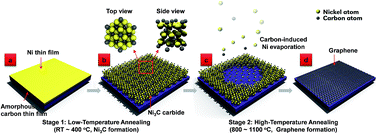Solid-state graphene formation via a nickel carbide intermediate phase†
Abstract
Direct formation of graphene with a controlled number of graphitic layers on dielectric surfaces is highly desired for practical applications but still challenging. Distinguished from the conventional chemical vapor deposition methods, a solid-state rapid thermal processing (RTP) method can achieve high-quality graphene formation on dielectric surfaces without transfer. However, little research is available to elucidate the graphene growth mechanism in the RTP method (heating rate ∼15 °C s−1). Here we show a solid-state transformation mechanism in which a metastable nickel carbide (Ni3C) intermediate phase plays a critical role in transforming amorphous carbon to two dimensional crystalline graphene and contributing to the autonomous Ni evaporation in the RTP process. The formation, migration and decomposition of Ni3C are confirmed to be responsible for graphene formation and Ni evaporation. The Ni3C-assisted graphene formation mechanism expands the understanding of Ni-catalyzed graphene formation and provides insightful guidance for controlled growth of graphene through the solid-state transformation process.


 Please wait while we load your content...
Please wait while we load your content...